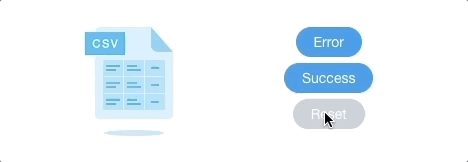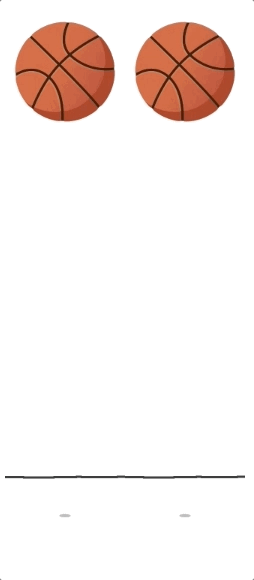react-sequence-animator
This is a supper simple React library that lets us create animations in an easy and straight forward manner.
The idea behind this library was to create animations that can be controlled very easily.
For example, a loader that has smooth transitions to a success and fail mode:
How to Install
npm install --save react-sequence-animatoror
yarn add react-sequence-animatorWhat You Get
The library has two components:
SpriteAnimator and SequenceAnimator.
SpriteAnimator
The SpriteAnimator receives one child, which it respects as a sprite image, a getPosition function,
which for every frame number should return a position object of the form: {top: 0, left: 0, width: 100, height: 100},
and the number of frames in the sequence.
In order to use this component you should know where each frame is located in the sprite image.
import { SpriteAnimator } from 'react-sequence-animator';
import sprite from './sprites-cat-running.png';
const WIDTH = 512;
const HEIGHT = 256;
class SpriteAnimatorStory extends React.Component {
constructor() {
super();
this._getPosition = this._getPosition.bind(this);
}
render() {
return (
<SpriteAnimator autoplay numOfFrames={8} getPosition={this._getPosition}>
<img src={sprite} alt="my-sprite" width={WIDTH * 4} height={HEIGHT * 2}/>
</SpriteAnimator>
);
}
_getPosition(frame) {
return {
width: WIDTH,
height: HEIGHT,
top: (frame < 4) ? 0 : HEIGHT,
left: (frame % 4) * WIDTH
};
}
}The SpriteAnimator receives several props:
| Name | Type | default | Description |
|---|---|---|---|
children |
a single node | --- | the sprite to be "played" |
getPosition |
function | () => {top: 0, left: 0, width: '100%', height: '100%'} | a function that is called for each frame and should return the position of the frame in the sprite |
numOfFrames |
number | 0 | the number of frames in the animation |
autoplay |
bool | true | should play automatically or not |
duration |
number | 1000 | the duration in milliseconds of the animation |
loop |
bool | true | should play in a loop |
easing |
string | 'linear' | the easing of the animation (read more about this here) |
onSequenceEnd |
func | () => {} | a callback function that is called each time the sequence reached its end |
onAnimationStop |
func | () => {} | a callback function that is called when the animation stops completely |
Notice: There's no restriction on the type of element the child should be. It can also be an SVG or even a react component or a div
API
play - Plays the animation (from the current frame)
stop - Stops the animation
reset - Resets the animation to the first frame (0)
SequenceAnimator
The SequenceAnimator receives a sequence of images as its children, and "plays" them one after the other.
import { SequenceAnimator } from 'react-sequence-animator';
import cat1 from './statics/cat1.png';
import cat2 from './statics/cat2.png';
import cat3 from './statics/cat3.png';
import cat4 from './statics/cat4.png';
import cat5 from './statics/cat5.png';
import cat6 from './statics/cat6.png';
import cat7 from './statics/cat7.png';
import cat8 from './statics/cat8.png';
class SequenceAnimatorExample extends React.Component {
render() {
return (
<SequenceAnimator>
<img src={cat1} alt="cat1"/>
<img src={cat2} alt="cat2"/>
<img src={cat3} alt="cat3"/>
<img src={cat4} alt="cat4"/>
<img src={cat5} alt="cat5"/>
<img src={cat6} alt="cat6"/>
<img src={cat7} alt="cat7"/>
<img src={cat8} alt="cat8"/>
</SequenceAnimator>
);
}
}The SequenceAnimator receives several props:
| Name | Type | default | Description |
|---|---|---|---|
children |
node or array of nodes | [] | the nodes to be "played" |
autoplay |
bool | true | should play automatically or not |
duration |
number | 1000 | the duration in milliseconds of the animation |
loop |
bool | true | should play in a loop |
easing |
string | 'linear' | the easing of the animation (read more about this here) |
onSequenceEnd |
func | () => {} | a callback function that is called each time the sequence reached its end |
onAnimationStop |
func | () => {} | a callback function that is called when the animation stops completely |
Notice: There's no restriction on the types of elements the children should be. They can also be SVG's or even react components or divs
API
play - Plays the animation (from the current frame)
stop - Stops the animation
reset - Resets the animation to the first frame (0)
Easing
The components can apply to the animations, easings as described in the library easing-utils.
It was initially introduced in order to allow control of the animation's duration (using the linear easing), but other easings may be applied.
It is recommended to use easings only on linear animations.
Notice: When using easings other than linear, we cannot be assured that all frames will be played
Example:
Both of the basketball animations above use the same sequence of images.
The right animation is played with a linear easing; A ball falling in a constant velocity.
Adding the easing easeOutBounce gives us the feeling of a ball in free fall, and bouncing after hitting the ground (left animation).
Notice how the eased animation (on the left) isn't as smooth as the linear animation.
That happens because the easeOutBounce skips some frames at the end.
In order to achieve a smoother animation, we would have needed much more frames (which really isn't cost effective).


